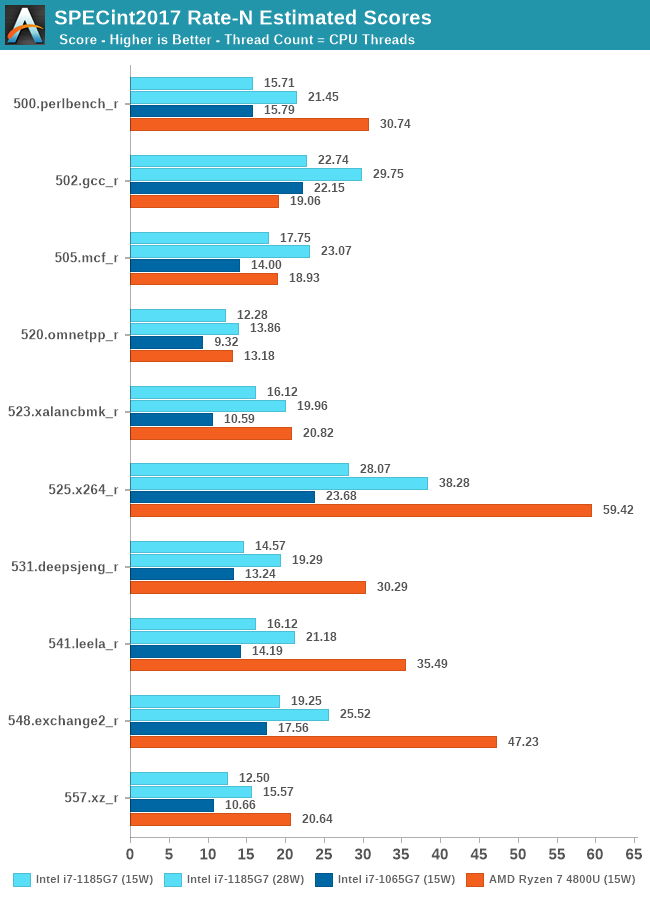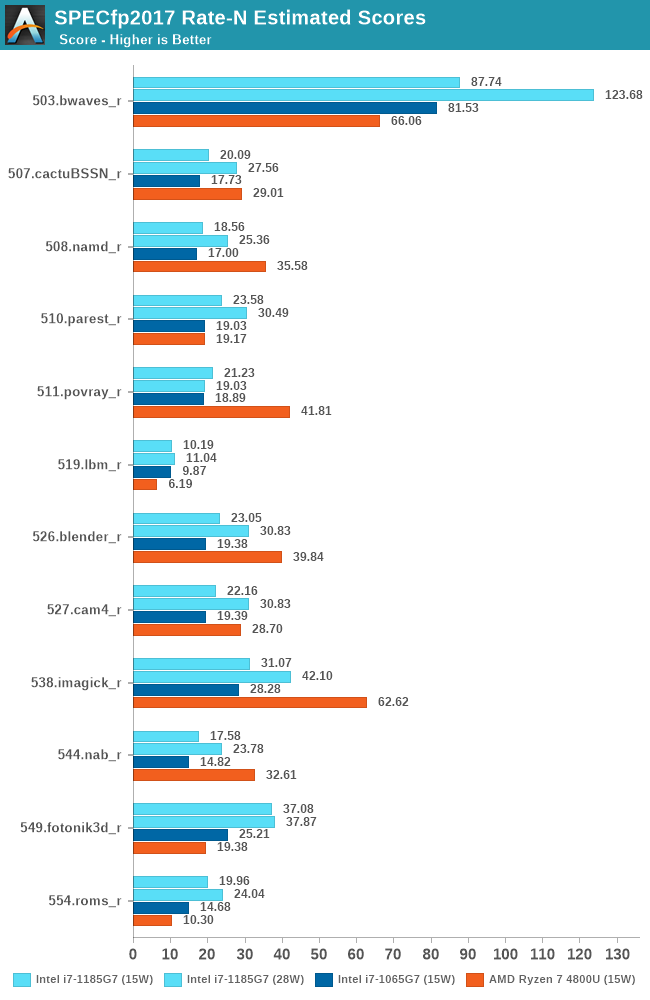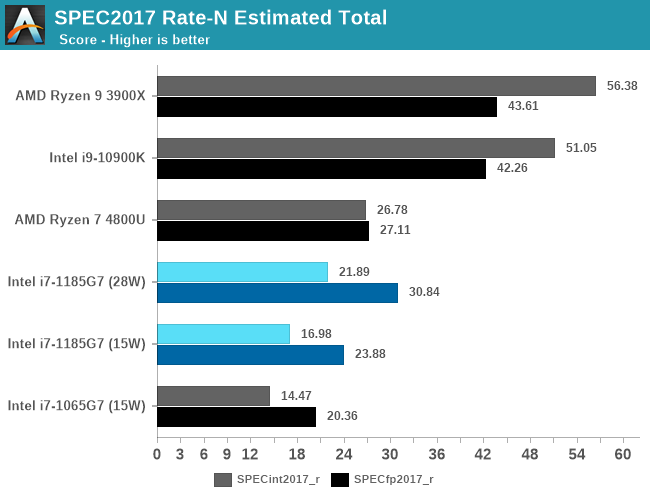Intel’s Tiger Lake 11th Gen Core i7-1185G7 Review and Deep Dive: Baskin’ for the Exotic
by Dr. Ian Cutress & Andrei Frumusanu on September 17, 2020 9:35 AM EST- Posted in
- CPUs
- Intel
- 10nm
- Tiger Lake
- Xe-LP
- Willow Cove
- SuperFin
- 11th Gen
- i7-1185G7
- Tiger King
Section by Andrei Frumusanu
CPU MT Performance: SPEC 2006, SPEC 2017
We’ve noted the earlier discussions of Intel’s TDP handling and how Tiger Lake has 15W and 28W operating modes, and where this comes into play the most is in multi-threaded scenarios where the platform is generally power envelope limited, having to otherwise clock down.
We’re showcasing the MT performance in SPEC for both the Tiger Lake modes, comparing it to both the 15W Ice Lake and AMD Renoir chips. As a note, the 15W Ice Lake platform had a sustained power draw of 18W which makes things not quite as apples-to-apples. Also as a reminder, the Intel systems have 4 cores and are running 8 thread instances, while the AMD system has 8 cores and is running 16 threads.

At first glance, the Tiger Lake system performs quite well versus its predecessor, but that’s mostly only in the 28W mode. At 15W, the generational boost, while it is there, isn’t that significant. This might point out that efficiency isn’t all that much better this generation.
AMD’s platform scales incredibly well in execution-bound workloads as it fully takes advantage of double the core count. In more memory-heavy workloads, the Zen2 cores here seem to be lacking sufficient resources and scale below the performance of Intel’s 4-core designs in some workloads.

In the floating-point results, it’s again a matter of TDP headroom as well as memory performance scalability. In the 15W results, the Tiger Lake chip posts rather small improvements over its Ice Lake counterpart, whilst in the 28W mode the gains are more considerable and even manages to outperform the AMD system more often than not.

In the overall scores, the verdict on Tiger Lake is dependent on how you evaluate Intel’s performance gains. At an (semi)equal-TDP level between Tiger Lake and Ice Lake, the improvements in performance are 17%. Intel does reach a larger 51% generational performance boost in its 28W configuration, but at that point we’re talking about quite different cooling solutions inside of a laptop, no longer making this a valid apples-to-apples comparison.
We haven’t had opportunity to test out higher TDP -HS model of Renoir yet, but with the 15W 4800U already mostly tied with the 28W i7-1185G7, we would expect it to notably outperform the Tiger Lake chip.
Overall, Tiger Lake seems to be offering roughly 20% better performance per watt over its predecessor, with increased performance beyond that coming at a cost of higher power consumption.










253 Comments
View All Comments
tipoo - Thursday, September 17, 2020 - link
“Baskin for the exotic”I see what you did there...
ingwe - Thursday, September 17, 2020 - link
I didn't get it until I read your comment.Luminar - Thursday, September 17, 2020 - link
RIP AMDAMDSuperFan - Thursday, September 17, 2020 - link
"Against the x86 competition, Tiger Lake leaves AMD’s Zen2-based Renoir in the dust when it comes to single-threaded performance." - But I am hoping Big Navi can compete well against this Intel chip.tipoo - Thursday, September 17, 2020 - link
What does Big Navi have to do with a laptop CPU?AMDSuperFan - Thursday, September 17, 2020 - link
You care about games don't you? This Intel Tiger won't have an answer for Big Navi. We can look forward to that showing who is the boss.blppt - Thursday, September 17, 2020 - link
Based on preliminary data, they'll both be about 2 years behind Nvidia, what with Big Navi only matching a 2080ti, and not available for another month at the earliest.hecksagon - Friday, September 18, 2020 - link
Crazy how you can make that prediction, the only preliminary data that is out is a photograph of the card. Are you a wizard?blppt - Friday, September 18, 2020 - link
Incorrect.https://wccftech.com/amd-radeon-navi-gpu-specs-per...
HarryVoyager - Friday, September 18, 2020 - link
I'm not really seeing where you are getting that from. We know that RDNA2 can hit 2.23Ghz from the PS5 implementation, and we have solid rumors that it the top end one will be an 80CU chip, rather than a 40 CU chip. That implies on the order of a 230% improvement over the 5700XT, if their are no other performance improvements. That alone puts it in the 30-40% improvement range over the 2080 Ti. Given we've already seen at least a few AMD benchmarks of unidentified cards showing a 30-40% improvement over 2080 To performance, that sort of lift does seem likely.If I had to guess, that RDNA2 that recently showed up with a near 2080 TI performance is probably a 6700 competitor to the 3070, not the top end card. Those do have to be developed and tested too, after all.